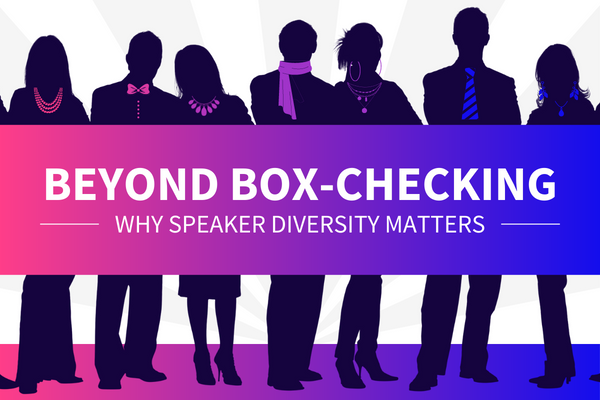Nowadays, it’s increasingly common for businesses, non-profit groups, and other organizations to bring in guest speakers. Sometimes, they’re educators and there to inform their audience. Other times, they’re motivational speakers, ready to inspire their audience to action and get them on their feet. If this sounds like you, and you’re wondering how to become a guest speaker, this is the guide for you.
Although guest speaking varies from event to event, there are a few “givens” that will make you stand out from other speaker options. Of these proven strategies, many are also good rules of thumb no matter what your goals are in the speaking industry. If you want to be a world-renowned keynote speaker, for instance, these can help you get there. Conversely, if you’re just looking for small events in your local area, these tips will speed up your efforts, too.
So, without further ado, let’s dive into how to become a guest speaker! We’ll also touch on a few additional resources you can use to implement each of the five steps below. That way, you won’t just have a vague idea of what to do. You’ll also have definitive steps to turn your goal into reality. 💪
Define your message and your ideal audience.
Step 1 of how to become a guest speaker is pinning down your speech topic and audience. The first component, your message, is all about your primary area of expertise. To narrow this down, ask yourself, “What is the main thing I want my audience to know when they leave?” This can be inspired by your past personal or professional experiences or by your passion for a given topic. It can also be a broad message that applies to many audiences but has a specific link to your life.

A good example of this is the content for speaker and comedian Frank King. Although King speaks about the importance of mental health, he specifically ties it to his experience in comedy. To put it simply, his message is, “You can make a difference, you can save a life, and often you can do it by starting a conversation,” a serious statement he then balances with his trademark humor. King also narrows that message – and his jokes – even further, focusing on specific industries, including construction and education.
That brings me to the second component, your ideal audience. After defining your message, the next question to ask yourself is, “What groups of people can benefit the most from hearing it?” Another question to consider is, “Who am I most passionate about serving?”
Becoming a guest speaker is first and foremost about finding where your answers to these questions and your message overlap. That way, your speech has the greatest impact from the beginning. Plus, if you can already articulate your ideal audience, event organizers serving that audience will want to hire you on the spot. What’s not to love about that?
Prepare your personal branding materials.
Second, learning how to become a guest speaker isn’t solely about the message you bring to the table. It’s also about you, as an individual. Now more than ever, the speaking industry is rapidly expanding. Among speakers, that means more competition for opportunities, and, among event planners, that means more options to consider when trying to find the best fit for their event.

Considering this, when designing your speaking business, your job is to do everything you can to stand out. From your website to your speaking materials, the more polished and professional you look, the more likely event organizers will remember you when they need to hire someone.
For all of your brand assets, it’s also important to be consistent. This includes colors, fonts, language, and overall visual style. By keeping each of these elements uniform across your brand, you present an elegant and eye-catching image of you on stage. You also suggest a kind of “ideal” compared to some of the other speakers a potential client may consider. To put it bluntly, if you look like you have your sh*t together and it looks good, you’ll stand out from the crowd every time.
If you haven’t already established a personal brand or if you’re in the process of building one, below are the materials you should have at a minimum.
- Speaking Website (to share photos of you on stage and the other materials listed below)
- Program Descriptions (to outline the different pre-written speeches you offer, what audiences gain from them, and how long they are)
- Testimonials (to highlight your happiest clients)
- Approved Photos of You (so event planners can easily access them to promote your appearance at their event; should be high resolution and include a headshot)
- Speaker Biography (to share your background and establish credibility)
Produce content for your target audience and share it widely.
Moving on, the third step in how to become a guest speaker is time-consuming but incredibly important. I’m talking about content production.
Like defining your message and audience in your speaking materials, producing content allows you to demonstrate who you serve. If you’re focused on guest speaking for religious organizations, for instance, your content might be about theology. If your primary audience is college students, your content could be about student debt or mental health. Whatever your message and whoever your audience may be, content allows you to show you’re there for them.

More importantly, however, creating and sharing content in your focus industry allows you to share your ideas. For many event organizers, they’re not necessarily looking for a speaker, specifically. They’re looking for a thought leader that can help them meet their goals while also keeping their audience engaged. Consequently, if you want to consistently book gigs as a guest speaker, position yourself as an expert, then a speaker.
Then, consistently create content for your target audience. Below are a few common content channels.
- Blogs: Blogs are written content, usually centered around a specific topic or keyword. They can be informative, like news articles. You can also make the text more engaging by including gifs, videos, and graphics.
- Podcasts: Podcasts are audio-only. You can record yourself solo or interview guests about their unique experiences or insights.
- Social Media Videos: Social videos tend to be the most informal and personal area of content. They can be long or short, pre-recorded or live, but all tend to be more interactive than other content channels.
- YouTube Videos: YouTube videos can also be long or short and pre-recorded or live. You can also embed videos from YouTube in your blogs to supplement your written content.
Build relationships within your focus industry(ies).
Step 4 of how to become a guest speaker is networking. Within the speaking industry, one of the ideas shared most often is “the importance of connections.” This includes connections between speakers, connections between speakers and event organizers, speakers and bureaus, speakers and coaches (like SpeakerFlow) – you name it!

In the same way, one of the fastest and most effective ways to become a guest speaker is by making connections within your focus industry. One way to do this is through contributing to other industry experts’ content. Remember how I mentioned blogs in the last section? You can guest write for those on other industry experts’ websites! Remember podcasts? You can appear on those, too, as a guest!
Essentially, in each of these actions, your goal is to build relationships. Sure, many of your collaborators won’t hire you, and that’s a bummer. But, because of their content, your name will reach more people throughout your focus industry. That means more people reading your content, considering you an authority figure, and thinking of you when they – or someone they know – is looking for guest speakers.
Additionally, by connecting with others, you demonstrate that you’re in this for the long haul. You don’t just want to get booked, take the money, and run. You want to support your audiences and continually contribute to the articles, videos, podcasts, and events that help make their industry better year over year. That fact alone makes you a more likeable person and a more appealing hire, no matter what industry(ies) you’re in.
Follow up with clients to ask for feedback and referrals.
Last but not least, the final step of how to become a guest speaker is always circling back after an event is over. Although it may seem pointless at first, there are three main reasons it’s always worthwhile. First is feedback. If you want to stand out from other speakers and command increasingly higher speaking fees, you have to always be on the lookout for ways to improve.

The second is referrals. According to recent research, more than 50% of speakers attribute the bulk of their business to referrals. This means that an incredible number of event planners are happy to recommend you to others in their network, especially if you’ve worked with them more than once. All you have to do is ask, “Can you recommend a few others who could benefit from the presentation we just finished?”
And, finally, the last reason to circle back is for testimonials. I mentioned above that the speaking industry is all about connections. Like it or not, that includes people your potential clients don’t even know. In other words, potential clients will almost always look at your reviews from other clients before hiring you. Ensure that those reviews are positive – and combine them with the four steps above – and you’ll be a prominent guest speaker in no time.
Hopefully, this quick and easy guide helps you master how to become a guest speaker in the coming months and, in doing so, help make the world a little bit better.
For more information about guest speaking versus keynote speaking, check out our previous guide detailing the differences between these two styles.
Additionally, for more information about finding guest speaking opportunities, see our speaking engagements list. 👌






